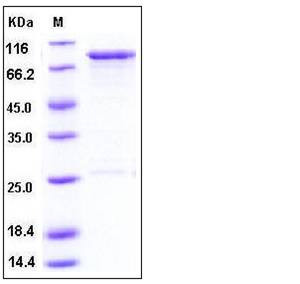Human OXSR1 / OSR1 Protein (GST Tag)
OSR1
- 100ug (NPP4137) Please inquiry
| Catalog Number | P10727-H09B |
|---|---|
| Organism Species | Human |
| Host | Baculovirus-Insect Cells |
| Synonyms | OSR1 |
| Molecular Weight | The recombinant human GST/OXSR1 chimera consists of 752 amino acids and predicts a molecular mass of 84 kDa. It migrates as an approximately 80 kDa band in SDS-PAGE under reducing conditions. |
| predicted N | Met |
| SDS-PAGE |  |
| Purity | > 88 % as determined by SDS-PAGE |
| Protein Construction | A DNA sequence encoding the full length of human OXSR1 (NP_005100.1) (Met 1-Ser 527) was fused with the GST tag at the N-terminus. |
| Bio-activity | Kinase activity untested |
| Research Area | Immunology |Signal Transduction |Protein Kinase |Intracellular Kinase |Other Intracellular Protein Kinases |
| Formulation | Supplied as sterile 50mM Tris, 100mM NaCl, pH 8.0, 0.5mM GSH, 0.5mM PMSF, 0.5mM EDTA, 10% glycerol 1. Normally 5 % - 8 % trehalose, mannitol and 0.01% Tween80 are added as protectants before lyophilization. Specific concentrations are included in the hardcopy of COA. |
| Background | Oxidative stress-responsive 1 protein (OXSR1), also known as Serine/threonine-protein kinase OSR1, is a member of the Ser/Thr protein kinase family of proteins. OXSR1 regulates downstream kinases in response to environmental stress, and may play a role in regulating the actin cytoskeleton. OXSR1 is a 58 kDa protein of 527 amino acids that is widely expressed in mammalian tissues and cell lines. The amino acid (aa) sequence of the predicted OXSR1 protein is 39% identical to that of human SOK1. Of potential regulators surveyed, endogenous OXSR1 is activated only by osmotic stresses, notably sorbitol and to a lesser extent NaCl. OXSR1 did not increase the activity of coexpressed JNK, nor did it activate three other MAPKs, p38, ERK2, and ERK5. Phosphorylation by OXSR1 modulates the G protein sensitivity of PAK isoforms. The OXSR1 and SPAK are key enzymes in a signalling cascade regulating the activity of Na+/K+/2Cl- co-transporters (NKCCs) in response to osmotic stress. Both kinases have a conserved carboxy-terminal (CCT) domain, which recognizes a unique peptide (Arg-Phe-Xaa-Val) motif. The OXSR1 and SPAK kinases specifically recognize their upstream activators and downstream substrates. |
| Reference |
